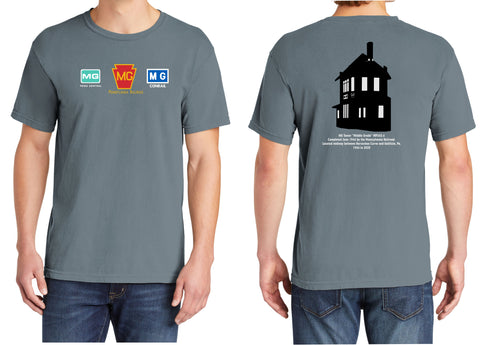
Lehigh and New England FA Logo Shirt
Lehigh and New England FA Logo Shirt
- Printed on Front and Back
- 100% Cotton 5.5 oz Hanes Comfort Wash
- Shirt Color - Saltwater
The Lehigh and New England Railroad (L&NE) was organized April 2, 1895 as the successor to the PP&B. The route from Slatington to Pine Island was accomplished but not completed. The L&NE was able to have a route from Slatington to Pine Island even though the route wasn't completed because the L&NE had obtain trackage rights over the New York, Susquehanna and Western Railway's Sparta Junction to Columbia/Delaware Junction main line between Swartswood Junction (outside of Swartswood) and Hainesburg Junction; this line was built by the New Jersey Midland Railway from Sparta Junction to Blairstown, New Jersey and by the Blairstown Railway from Blairstown, New Jersey to Columbia/Delaware Junction and today serves as the Paulinskill Valley Trail. Despite that, a tunnel (40°58′44″N 74°46′1″W) was built under the fill for the Delaware, Lackawanna and Western Railroad's New Jersey Cut-Off (opened 1911) in case the L&NE ever decided to complete its own line. Additionally, the planned route from Pine Island to Campbell Hall was cancelled, and trackage rights were obtained over the Erie Railroad's Goshen and Deckertown Railroad and Montgomery and Erie Railroad.
The Lehigh and Lackawanna Railroad and its leased Wind Gap and Delaware Railroad were operated by the Central Railroad of New Jersey until February 1, 1905, when the two companies were merged into the L&NE. Around the same time the L&NE acquired the Northampton Railroad. This gave the L&NE a branch to Bethlehem, with a branch off that one to Martins Creek. Part of the main line between Benders Junction (the crossing of the original L&NE and the L&L) and Pen Argyl was abandoned in 1905, with the new route using the L&L and WG&D.
The Lehigh Coal and Navigation Company (LC&N) gained control of the L&NE on May 9, 1904.
A yard at Maybrook, New York opened in 1912, with L&NE trains terminating there via a section of the Central New England Railway.
On July 24, 1912 a new extension opened, splitting from the main line at Danielsville, Pennsylvania and running west to Tamaqua to directly serve the LC&N. On December 14, 1913 the L&NE acquired the Panther Creek Railroad, running east from Tamaqua to Summit Hill, and with a connection to the Central Railroad of New Jersey's Hauto Tunnel for access to Nesquehoning obtained in 1915.
On June 4, 1926 the Reading Company leased the L&NE, but other railroads objected, and the Interstate Commerce Commission rejected the lease, preferring a lease by the New York, New Haven and Hartford Railroad (which was never done).
The never-used tunnel (at right) for the Lehigh & New England under the now-abandoned Lackawanna Cut-Off. NJ Route 94 uses the tunnel on the left). The tunnel is now an integral part of Knowlton's Tunnel Field, a sports and recreation area that spans the Cut-Off via this tunnel.
The LNE Board of Directors decided to end all railroad operations on October 31, 1961. Although the LNE was still profitable, the rapid decline of the anthracite coal business was seen on the horizon and the decision was made to cease operations. By this date the LNE mainline saw only one coal train per week (which usually operated on Thursdays). Trackage was removed by the following year and the bridges over the Lehigh River and Delaware River were dismantled by 1969.
While a never particularly profitable system because it paralleled the Lehigh & Hudson River Railway and did not serve any large markets, the L&NE did have a profitable cement business from its lines around Bath, Pennsylvania; the trackage which served this commodity was taken over and operated by the Central Railroad of New Jersey (CNJ), then by the Lehigh Valley in 1972 when the CNJ's lease on its Pennsylvania trackage expired and was not renewed.[citation needed] To railfans, the L&NE is best remembered for its diesel motive power, which consisted entirely of models built by Alco.




